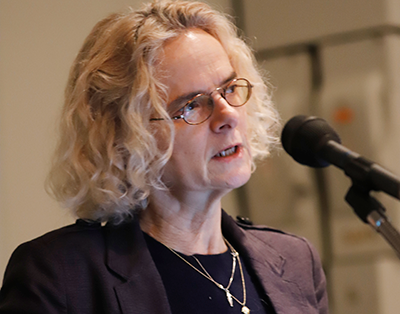Nora Volkow, M.D., Outlines NIDA’s Marijuana, Opioid Research Goals

The start of this year’s Annual Meeting coincided with the 15th anniversary of Nora Volkow’s, M.D., appointment as director of the National Institute on Drug Abuse (NIDA). To celebrate, Volkow (pictured above) presented a forward-looking lecture that explored some of today’s pressing issues in drug use and addiction, and how NIDA aims to address those problems.
Her lecture focused on two substances in particular: marijuana and opioids. While these drugs receive a lot of attention, Volkow noted that the drugs that remain the leading causes of death in the United States are alcohol and tobacco. “It’s not because these substances are more dangerous than opioids,” she said. “It’s because they are legal.”
Volkow explained that NIDA is paying close attention to what the decision to legalize marijuana in many states across the country will mean for the health of Americans. What’s beneficial for researchers is that the states that have legalized marijuana have approached regulations differently, which offers a good opportunity to see how different policies affect health outcomes.
How this increased marijuana availability will affect adolescents will be particularly important to study. Volkow cited recent national data that while the rates of substance use among teens have dropped for virtually every substance over the past few years, marijuana use rates have remained stable.
Marijuana is primarily inhaled, and smoking-related diseases take a long time to develop, but teen smoking is a unique consideration. “Adolescents are taking marijuana in a period in their life when they are learning greatly; being exposed to marijuana may disrupt their ability to learn and lead to long-lasting pharmacological effects.”
The Adolescent Brain Development Study (ABCD)—which plans to follow about 10,000 children from ages 9 to 21—will be valuable in addressing that question, Volkow continued (see related story). She added that as of May, ABCD has enrolled over 9,100 participants, so they are on their way to surpassing their enrollment goal. “For the first time, we will have a database, so we can understand what is considered normal adolescent brain development.”
While the availability of legal marijuana is rising, opioid prescriptions are falling, Volkow said, though prescribing rates are still high overall. “The problem now is that we have more people using illicit substances like heroin and synthetic opioids, and overdoses are rising.”
The increased use of naloxone is helping prevent some overdose deaths, though that leads to another research question for NIDA: What are the long-term consequences of overdose, and how do opioid combinations such as heroin and fentanyl affect the biology of hypoxia that follows an overdose?
NIDA is heavily invested in finding new medications for pain that are effective but not addictive, Volkow noted. Targets being explored include mu-opioid receptors and sodium channel blockers. Sodium channel blockers have been studied before and found to be not that effective on their own, but Volkow said that new preclinical research suggests that combining a sodium channel blocker with just a tiny amount of buprenorphine can produce a strong analgesic effect.
Not all opioid addiction can be prevented, though, said Volkow, and NIDA is continuing to research better modes of addiction therapy, especially non-pharmacological ones. Some examples include neurostimulation, both electrical and magnetic, and developing antibodies that bind to drug molecules in the blood—essentially a vaccine to prevent addiction.
Even as NIDA continues to support studies to improve treatments for opioid use disorder, Volkow noted patients today can benefit from medication-assisted therapy, including buprenorphine or naltrexone. The big limitation for patients today, she added, is lack of access.
“Psychiatrists need to be more involved in treating addiction,” Volkow concluded. “I hope I can convince you to get your waivers, so you can prescribe buprenorphine, and actively screen and treat your patients for substance use disorders,” she said.
(Image: David Hathcox)
|
|
|
|
Advertisement
 |
|
 |
|
|


